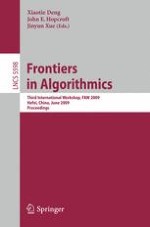This book constitutes the refereed proceedings of the Third International Frontiers of Algorithmics Workshop, FAW 2009, held in Hefei, Anhui, China, in June 2009. The 33 revised full papers presented together with the abstracts of 3 invited talks were carefully reviewed and selected from 87 submissions. The papers are organized in topical sections on graph algorithms; game theory with applications; graph theory, computational geometry; machine learning; parameterized algorithms, heuristics and analysis; approximation algorithms; as well as pattern recognition algorithms, large scale data mining.
